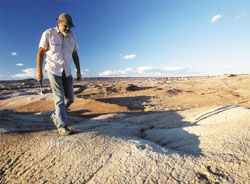|

The Missing Piece
James Clark Reconstructs the Evolutionary Puzzle

|

Biology professor James Clark searches for
fossils in Xinjiang, China.
|
To James Clark, Velociraptors are not just the fast-moving
predators that terrorized moviegoers in Jurassic Park;
they are links in a chain connecting dinosaurs to modern
birds. The Ronald Weintraub associate professor of biology
also knows the crocodile’s smile—or, rather,
skull and powerful jaws—developed on land long
before its swim-adept body. From GW’s labs to the
Gobi Desert in China, Clark seeks the missing pieces
in the evolutionary puzzle.
“There is nothing as thrilling as uncovering a
skeleton of a never-before-seen animal that has been
buried for thousands of millennia,” Clark says. “Anticipating
a discovery is almost as much fun as the discovery itself.”
On a series of field projects funded by the National
Science Foundation and GW’s University Facilitating
Fund, Clark has been exploring the Middle to Late Jurassic
Shishugou Formation, located in Xinjiang in northwestern
China, searching for links between birds and theropod
dinosaurs, which are carnivorous bipeds with small limbs.
The expeditions, conducted since 2000, have resulted
in the collection of many other fossils, including crocodilians,
mammals, pterodactyls, and herbivorous dinosaurs.
Clark also has spent 10 years collecting dinosaurs in
Mongolia, notably theropods sitting on nests and embryonic
dinosaurs in eggs. And his earlier field work in northeastern
Mexico also resulted in the discovery of a new species
of the flying reptile group Pterosauria.
Now, with a shared $3 million NSF Tree of Life grant
awarded in 2002, Clark and research partners are creating
an online database of theropod and bird form and structure
characteristics. In stocking the database, the researchers
are determining the relationships of the major groups
of birds and the evolution of their anatomical features
involved in their transition from theropod dinosaurs. “The
online database will provide virtually every important
piece of evidence for what happened during this transition,
for all to see,” Clark says.
Some database information will come from a report by
Clark and researchers at the University of Utah that
was published in May in Nature that details the discovery
of a mass graveyard of bird-like feathered dinosaurs
in Utah. The previously unknown species, Falcarius utahensis,
leaves clues about how meat-eaters related to Velociraptors
evolved into vegetarians. While it is not yet known whether
the species ate meat, plants, or was omnivorous, it shows
the beginnings of features associated with herbivorous
dinosaurs, such the expansion of the gut to a size required
to ferment plants.
The graveyard was found thanks to a commercial fossil
collector who later was convicted of fossil theft. In
Clark’s experience, research clues often come from
unexpected sources.
During the first of four visits to Xinjiang, his team
sought small dinosaur remains relating to their study
of the evolution of birds—and left finding an important
link in the evolution of the crocodile. Clark co-wrote
a study published in Nature in August 2004 stating that
while modern crocodiles are semi-aquatic dwellers, its
skull and jaws evolved on dry land long before its swim-tuned
body. The fossil is the most complete known skeleton
of a land-dwelling crocodilian ancestor. The three-foot
long creature, believed to have lived about 150 million
years ago, was named Junggarsuchus sloani after National
Geographic editor Chris Sloan, who found the fossil in
2001 during that first expedition to Xinjiang.
Clark says Junggarsuchus’s skull is similar to
the skulls of modern crocodilians, but that its body
more closely resembles those of sphenosuchians—a
class of slender, land-dwelling crocodilians living from
about 230 million to 150 million years ago. Its forelimbs
are more adapted to land walking than those of sphenosuchians.
While many of the fossils the team found in China remain
there, a backlog of specimens from the four visits is
housed at GW. “Even if I didn’t have any
more grant funding, there are so many fossils we have
already found, there’s decades of work,” Clark
says.
In addition to Junggarsuchus slonai, Clark says the
expedition may have sparked other significant findings—including
several new species of dinosaurs. The Shishugou Formation
is one of the world’s few fossil deposits that
has preserved dinosaurs from the time when they had just
begun to reach enormous sizes and dominate the world’s
terrestrial ecosystem.
Clark plans to return to Xinjiang to continue the field
work. There are more secrets to be found in the rocks.
—Laura Ewald
To learn more about Clark’s work, visit www.gwu.edu/~clade/faculty/clark/china.html
|